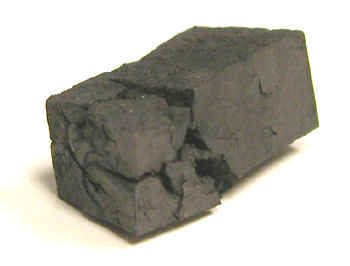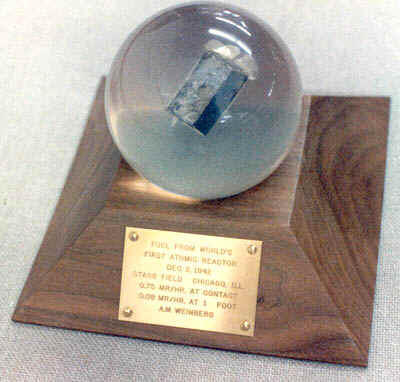Fuel from CP-1

The fuel employed in CP-1 was natural (unenriched) uranium. Most of it, some 40 tons, consisted of uranium oxide pressed into 17,000 “pseudospheres” approximately 3 inches in diameter.
In addition to uranium oxide, approximately 6 tons of uranium metal was used as fuel. The uranium metal was fashioned into cylinders 2.25 inches in diameter and 3 inches long at Iowa State University under the direction of Frank Spedding. They came to be referred to as “Spedding’s eggs.”
The piece on display is uranium oxide.

On the tenth anniversary of CP-1 going critical, a small piece of fuel, encased in plastic, was presented to those who assisted Enrico Fermi in the design and construction of the reactor. This particular piece was presented to Alvin Weinberg. The brass plate on the mahogany base used to hold the sphere reads "Fuel from world's first atomic reactor. Dec. 2, 1942. Stagg Field, Chicago Ill. 0.75 mR/hr at contact, 0.08 mR/h at 1 foot. A.M. Weinberg."
In the late 1990s, the sphere spontaneously shattered, probably due to a discharge of accumulated energy.
Donated by Alvin Weinberg.
Alvin Weinberg
Dr. Weinberg contributed to the design of CP-1 by determining the optimal spacing for the fuel elements. He subsequently made a similar contribution to the design of the Oak Ridge Graphite Reactor. In 1958 he and Eugene Wigner co-authored what has come to be the standard text on reactor theory—“the Physical Theory of Neutron Chain Reactions.” He is probably the individual most responsible for the development of pressurized water reactors, and showed Hyman Rickover how such reactors could power a nuclear navy. Among his other accomplishments: he served as director of Oak Ridge National Laboratory, made the original proposal for the formation of the American Nuclear Society, and coined such terms as “technological fix,” “nuclear priesthood” and “big science.”
